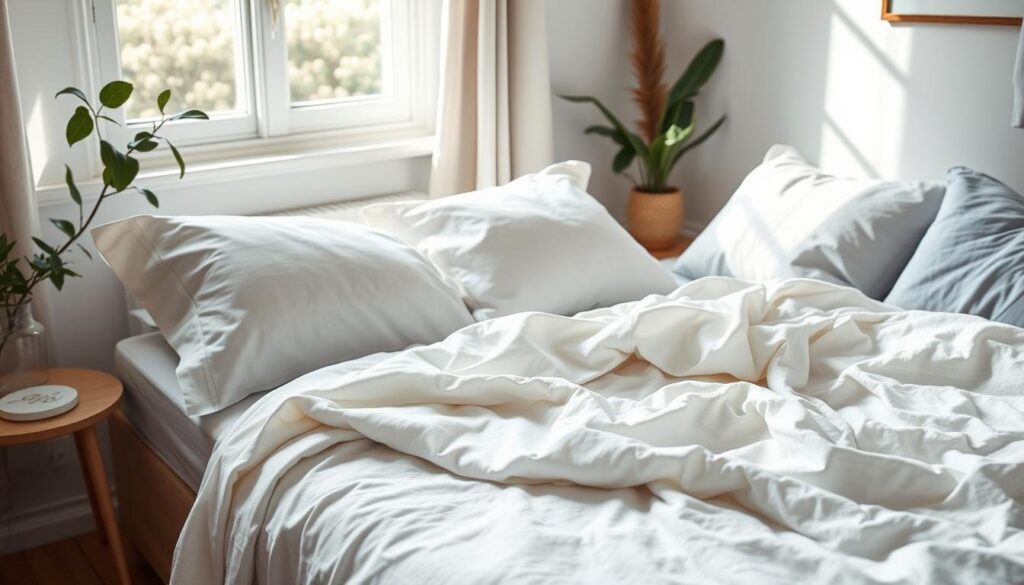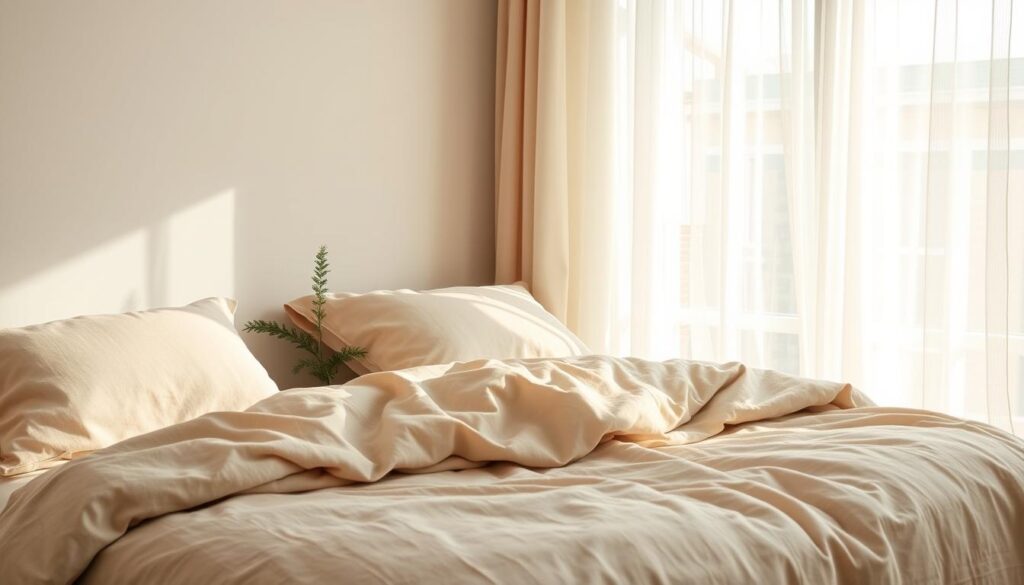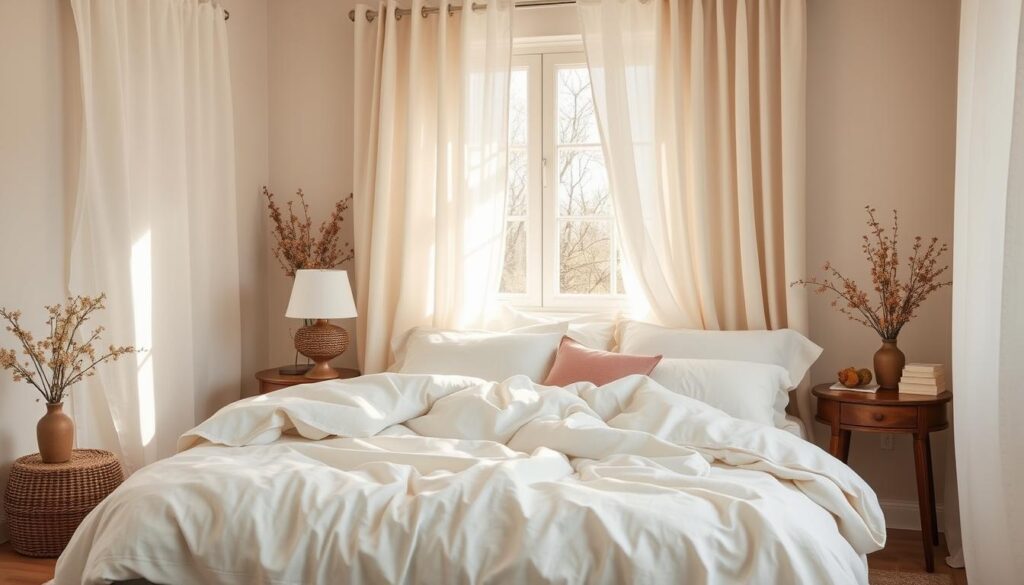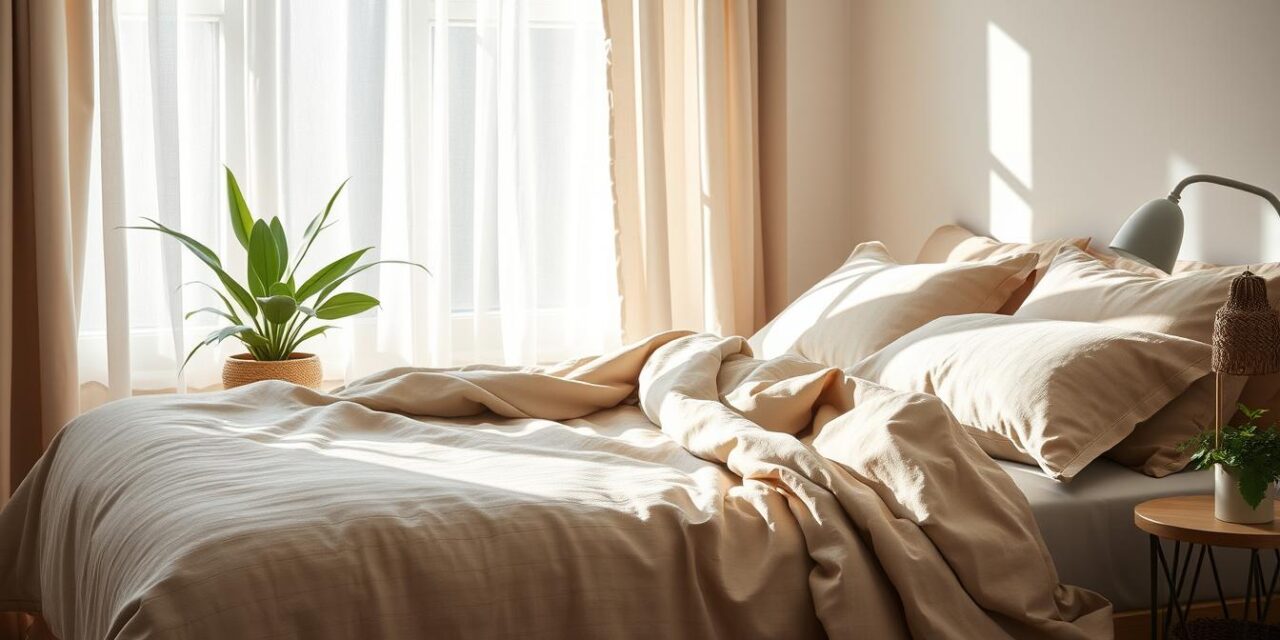Australians spend about 26 years sleeping, which is almost a third of our lives. This shows how important sleep is to us. Linen, a natural fibre, is changing how we think about sleeping.
Linen bedding is popular for its comfort, sustainability, and health benefits. It’s made from the flax plant. Linen is known for being breathable, regulating temperature, and lasting long. These qualities make it a favourite for those wanting a better sleep.
Key Takeaways
- Linen bedding is a natural fibre that can improve sleep quality
- Linen is highly breathable and regulates temperature for all-season comfort
- Linen is a durable and sustainable choice for bedding
- Linen has hypoallergenic and antibacterial properties for healthier sleep
- Linen bedding can be a worthwhile investment for long-term use
Understanding the Natural Appeal of Linen Bedding
Linen has been around for thousands of years. It’s a versatile, eco-friendly fabric that’s perfect for sustainable bedding. Let’s explore linen’s journey from ancient times to its modern popularity in luxury bedding.
The Ancient History of Linen
Linen’s history starts in the Neolithic period, when people first grew flax plants. The ancient Egyptians were among the first to see its beauty and strength. They used it for pharaohs and mummies. Linen’s fame has grown over time, loved by many cultures.
From Flax to Fabric: The Manufacturing Process
Making linen is a detailed process. It starts with growing flax plants. Then, the fibres are separated, spun, and woven into linen. This careful work makes linen eco-friendly, durable, and long-lasting.
Modern Revival in Bedding Choices
Lately, people are choosing linen for its eco-friendly and sustainable bedding options. Linen keeps you cool, is good for allergies, and looks elegant. It’s a top pick for those who want quality, comfort, and care for the planet.
“Linen is the fabric of the ages, a timeless classic that continues to captivate the hearts and homes of discerning individuals around the world.”
The Science Behind Temperature Regulation in Linen Sheets
Linen is famous for keeping you cool or warm, depending on the weather. It’s a top pick for breathable bed linens in Australia’s changing climate. The secret lies in linen’s special structure and what it’s made of.
Linen comes from the flax plant, which can adjust to temperature changes. Its hollow fibers soak up and let out moisture well. This helps control the sleep area’s temperature.
- Linen fibers are naturally temperature-regulating, keeping you warm when it’s cold and cool when it’s hot.
- Linen sheets are very absorbent. They pull moisture away, keeping you dry and comfy all night.
- Linen lets air move freely, stopping heat from building up. This helps you sleep better.
“Linen’s ability to regulate temperature is a game-changer for anyone seeking a comfortable, refreshing night’s sleep, especially in Australia’s variable climate.”
Linen’s mix of temperature control and breathability makes it perfect for temperature regulating sheets. It offers a refreshing sleep all year round.

Why Linen Bedding Is Worth the Investment
Linen sheets might cost more than synthetic ones at first. But, they last longer and feel better for years. This makes linen a smart choice for your bedroom.
Durability and Longevity Factors
Linen is known for being very strong and lasting. It gets softer with each wash, keeping your bedding in top condition. This means linen bedding can be used for many years, offering great value.
Environmental Impact Considerations
Linen is also good for the planet. It’s made from flax that needs little water and no pesticides. Choosing linen bedding means you’re helping the environment while enjoying a comfy sleep.
| Feature | Linen Bedding | Synthetic Bedding |
|---|---|---|
| Durability | Exceptional | Moderate |
| Longevity | Long-lasting | Shorter lifespan |
| Environmental Impact | Sustainable | Less eco-friendly |
| Value | High | Moderate |
Linen bedding offers durability, long life, and eco-friendliness. It’s a smart choice for those wanting a sustainable, long-lasting, and luxurious sleep. Linen bedding is a great pick for your bedroom.

Breathability and Moisture-Wicking Properties
Linen bedding is famous for being breathable and moisture-wicking. It’s a top pick for Australians wanting a comfy sleep, especially in hot summer months. Its natural fabric keeps you cool and dry, helping to control your body temperature.
The unique cross-section of linen lets air flow through easily. This stops heat and humidity from building up. Unlike synthetic fabrics like polyester, linen doesn’t trap moisture and heat, making it more comfortable to sleep in.

Linen also excels at wicking away moisture. Its natural fibers absorb and release sweat quickly. This keeps you cool and dry, and also keeps your bedding fresh by stopping bacteria and odors.
For those who want a good night’s sleep, breathable bed linens and moisture-wicking bedding from linen are the best choice. Linen bedding offers a refreshing and rejuvenating sleep experience.
Health Benefits of Choosing Linen Bedding
Linen bedding is more than just stylish and comfy. It also has many health benefits. These make it a great choice for Australians looking for a good night’s sleep and skin care.
Hypoallergenic Properties
Linen bedding is great because it’s hypoallergenic. It naturally keeps away dust mites, mould, and other allergens. This is perfect for people with allergies or asthma, offering a calm and safe sleep space.
Antibacterial Characteristics
Linen has special antibacterial properties. The flax plant it comes from has natural compounds that stop harmful bacteria and mould from growing. This keeps your sleep area clean and healthy, reducing skin and breathing problems.
Skin-Friendly Features
Linen is soft and breathable, making it perfect for sensitive skin. It’s gentle and doesn’t cause irritation or rubbing. It also keeps you cool and dry, preventing skin issues like rashes or breakouts.
Choosing hypoallergenic bedding materials and skin-friendly bedding brings many health benefits. Linen helps Australians sleep better and wake up feeling refreshed.

Comparing Linen to Other Bedding Materials
Linen sheets and natural fiber bedding are becoming more popular. But how do they compare to cotton, silk, and synthetic fabrics? Let’s look at linen’s benefits for Australia’s climate.
Linen is lighter and airier than cotton, perfect for Australia’s warm weather. Silk feels luxurious but can’t beat linen’s breathability. This makes linen ideal for Australia’s humid nights.
Synthetic fabrics like polyester are cheap but can’t keep you cool. They trap heat, making you hot and restless. This ruins your sleep quality.
Linen is also good for people with sensitive skin or allergies. It’s antibacterial and hypoallergenic, offering a healthier sleep space.
“Linen is the ultimate natural fiber for bedding, offering unparalleled comfort, durability, and environmental sustainability – a true game-changer in the Australian sleep experience.”
In conclusion, linen’s breathability and ability to regulate temperature make it the best choice for Australians. It’s especially good during the warmer months.

Caring for Your Linen Bedding
Linen bedding is a luxury that can last for years with the right linen care. Whether you’re new to linen or not, knowing how to wash, dry, and store it is key. This helps keep your linens in top condition and makes them last longer.
Washing and Drying Guidelines
Washing linen sheets and duvet covers needs some basic steps. Use a gentle detergent and cool or warm water. Hot water can shrink or fade the fabric.
For drying, line-dry or tumble on low heat. This keeps the fabric’s shape and avoids creases.
Storage Recommendations
- Keep linen bedding in a cool, dry spot, away from sunlight to prevent colour loss.
- Don’t store linen in plastic or airtight containers as they can trap moisture and cause mildew.
- Fold linens neatly and stack them in a linen closet or drawer to keep their shape.
Extending Lifespan Tips
- Rotate your linen sheets regularly to spread out wear and tear.
- Invest in a quality linen duvet cover that’s easy to wash and replace.
- Spot-clean spills or stains right away to stop them from setting in the fabric.
By following these linen care tips, your bedding will stay soft, comfy, and last a long time. Enjoy a luxurious sleep for years to come.

Seasonal Adaptability of Linen Sheets
Linen bedding is a great choice for Australia’s changing weather. It’s not just for one season; it’s good all year. This makes sure you sleep well, no matter the weather.
Linen is very breathable, which helps control your body temperature. In hot weather, its open weave keeps you cool and dry. In cold weather, it keeps you warm and cozy, so you don’t need too many blankets.
This makes linen perfect for places with big weather changes. You can always sleep well, whether it’s hot or cold outside.
| Season | Linen Bedding Performance |
|---|---|
| Summer | Breathable and moisture-wicking, keeping you cool and dry |
| Winter | Retains warmth while regulating temperature, providing cosiness |
Choosing linen bedding means you can always have a comfy sleep space. It’s a smart choice for homes in Australia, no matter the season.

“Linen is the perfect bedding choice for Australians, as it keeps you cool in summer and cosy in winter – no matter where you live.”
Choosing the Right Linen Bedding for Your Needs
Choosing the right linen bedding can greatly improve your sleep and comfort. Two important things to think about are thread count and colour/style options. Knowing these can help you pick the best linen sheets for you.
Thread Count Considerations
The thread count of linen bedding shows how many threads are in each square inch. Higher thread counts were once seen as better, but linen’s natural fibres are stronger and last longer. So, linen with a lower thread count, between 100 and 300, can offer a luxurious and durable sleep.
Colour and Style Options
- Linen bedding comes in many colours, from whites and neutrals to vibrant tones and earthy shades. Pick a colour that matches your bedroom and style.
- Linen can have different patterns, like stripes, florals, or solids. This lets you find the perfect look for your room.
- There’s more than just flat sheets and pillowcases. You can also find duvet covers, shams, and fitted sheets to make your bed look great.
By looking at thread count and colour/style, you can get linen bedding that’s both beautiful and comfortable. Linen is known for its comfort and breathability. Let linen make your bedroom a dream place to sleep.
Sustainable Aspects of Linen Production
In Australia, the need for eco-friendly bedding is on the rise. Linen, made from the flax plant, is a natural choice. It’s biodegradable and has a lower environmental impact than many synthetic materials.
Linen is great because it breaks down quickly. This means it doesn’t stay in landfills for centuries like synthetic fabrics do. The flax plant also needs little water and no pesticides, making it a low-maintenance crop.
The way linen is made is also eco-friendly. The process creates very little waste. Even the leftover parts of the flax plant are used for other things, making linen production even more sustainable.
| Sustainable Aspect | Benefit |
|---|---|
| Biodegradability | Linen decomposes quickly and naturally, reducing landfill waste. |
| Low-impact cultivation | Flax plants require minimal water and pesticides, making them an eco-friendly crop. |
| Repurposed byproducts | The entire flax plant is utilized, minimizing waste in the manufacturing process. |
More Australians are choosing sustainable bedding. Linen is a top pick because it’s good for the planet. By picking eco-friendly linen and other sustainable bedding options, we can help the environment. We also get to enjoy the comfort and durability of linen.
Conclusion
In this guide, we’ve looked at why linen bedding is great for a good night’s sleep in Australia. We’ve covered its history, how it keeps you cool, and its health benefits. Linen is a top pick for a restful and refreshing sleep.
Linen keeps your body temperature just right and dries sweat quickly. This makes it perfect for a dry and comfy night’s sleep. It’s also good for people with allergies or skin issues because it’s hypoallergenic and antibacterial.
Choosing high-quality linen bedding is a smart move for Australians. It lasts long and is good for the planet. If you want to improve your sleep or find a healthier bedding option, linen is a great choice.





